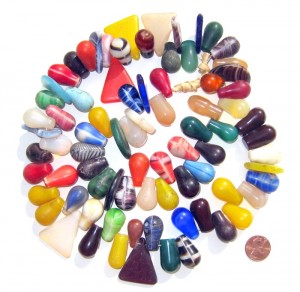A Buyers Guide To Mali Trade Beads – What To Look For, What To Avoid
Speckled, marbled, bulbous or triangular. Regardless of their shape, color, size or opalescence, there's no denying that Mali Wedding Beads are some of the most spectacular of African origin. From the simple way they refract and reflect light, to the way they hang when strung as a 'bouquet' for a focal necklace center-piece, Mali Wedding Beads exude a beauty and mystique that often belies their archaic history.
With the surge in popularity of auction sites as a primary means of retail, there has also been a ten-fold increase in the quantity of African beads being sold through these mediums. Mali Wedding Beads, along with Venetian Trade Beads, and African Chevrons comprise some of the most sought-after African bead variants, yet shopping for the 'real deal' has become a lot more challenging.
Why is it so difficult to source genuine Mali Beads?
The primary factor that has led to many questioning the authenticity of Mali Beads (that are not sold through accredited wholesalers and dealers), is the production of replicas and reproductions by both Middle Eastern and Western entities. Mali Wedding Beads can often command quite high prices, particularly if sufficient evidence accompanies them to prove they are of pre-1900 origin, and modern techniques are such, that it can be almost impossible to distinguish a reproduction from a true authentic bead.
Signs of Authenticity
If you've been an avid collector of African trade beads for a while, you will more than likely be familiar with the quality, weight and appearance of such old beads. African trade beads tend to have survived over a Century of exchange, travel, wear and tear to end up with the supplier selling them onto you. As a result, their general appearance, texture, and even structure may have suffered from such long life - characteristics loved by the people that collect them, and often what influences their high value in some cases. Other things to look for, or beware of include:
- Obvious Seams: It's generally very rare to come across Mali Wedding Beads that bear a pronounced or obvious seam. Part of their allure is the inherently smooth, glossy finish. If the Mali Beads you're looking at appear to have a prominent ridge from the bulb to the tip, chances are it is a modern reproduction.
- Threading Holes: Sounds daft doesn't it. Surely any bead should bear a threading hole, given their primary purpose is decorative. You'd be surprised at just how many 'replicas' are sold on a daily basis that do not feature this trademark Mali Bead characteristic! Old Mali Beads always bear a vertical threading hole at the 'head' of the bead (the part narrower than the bulb.) Modern variants are produced with a metal pendant fish-eye attachment or something similar, so that the bead can be used as a single pendant.
- Quantity: Authentic African trade beads are always sold by the string upon which they were sourced, by wholesalers committed to protecting the quality and authenticity of such beads. Such beads are often discovered in this state, and will have remained like this since they were first strung a hundred or so years ago. Sellers who break down African trade beads are usually those selling them on auction sites, out to make a quick profit with little regard for the authenticity, and historic relevance of keeping beads together.
- Number in Stock: Authentic trade bead retailers will usually be happy to inform you of the likelihood of certain beads coming back into stock, as well as their sources of stock. An extremely high number of 'bead strings' being sold through an independent dealer (particularly through marketplaces or auction sites) is indicative that they may not be genuine. Accredited dealers rarely have surplus. In fact, they tend to sell out of their authentic wares within days of it's arrival. Due to sourcing direct from Africa, it may also be a wait before such stock reappears upon their store catalog.
Other than the above, you should expect real Mali Wedding Beads to feature signs of wear and age. They may appear dirty, pitted, scratched, worn and even sun-bleached in some cases - all characteristics that indicate age, wear and extensive travel from one person to another. When your Mali Beads arrive, don't be disappointed to find them in such condition - it's part and parcel of their history, genuine character, and most importantly authenticity!
